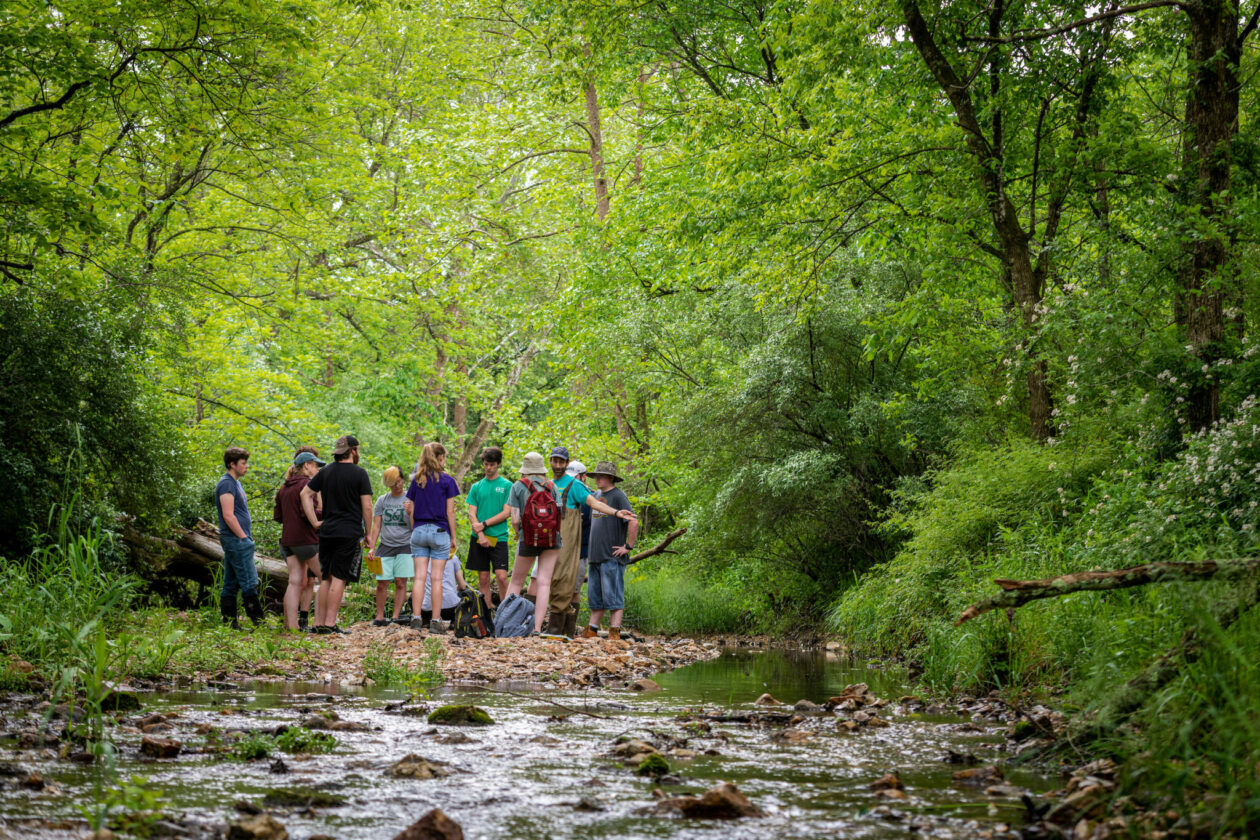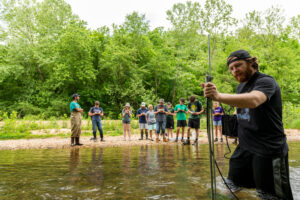S&T field laboratory continues to expand learning opportunities
Posted by Peter Ehrhard

Dr. Dev Niyogi, along with Missouri S&T alumna Amanda Lowe, teaches a summer field biology class based at Missouri S&T’s Ozark Research Field Station (OFRS) in the Bohigian Conservation Area. Photo by Michael Pierce/Missouri S&T
Staff at Missouri S&T’s biological resource site, the Ozark Research Field Station, have already hosted several summer classes this semester, covering topics such as field biology, insect ecology and vegetation of the Ozarks. And soon, the field station’s offerings could expand thanks to a gift from S&T alumnus Michael Haynes.
Currently, S&T students and researchers who visit the station must set up camping sites for overnight stays or commute to the remote site daily. But with a gift from Haynes and his wife, Deborah, the field station has begun construction of permanent facilities at the site, including bunk houses and showers.
“Oftentimes, the time that you spend after the field research is done can be the most important time at the site,” says Dr. Robin Verble, an associate professor of biological sciences at S&T and director of the Ozark Field Station. “It’s there that you discuss your findings with fellow students and researchers who might spark your next big idea, or you may find the answer to a problem you’ve been having with a current experiment. To do this, the field station needs facilities to accommodate overnight stays by multiple groups.”

Verble says a long-term goal of the field station is to accommodate up to 40 people per night at indoor locations, allowing not just faculty but even whole classes from the university to stay for longer research projects. Outside of the university, the station has hosted programs for local K-12 schools, Boy Scouts, Girl Scouts, local 4-H Club members and the U.S. Geological Survey.
Haynes earned a bachelor’s degree in chemistry from Missouri S&T in 1978. He retired from the Dow Chemical Co., and was a member of the W.T. Schrenk Society and Alpha Chi Sigma while a student at S&T.
“Michael visited our site as a part of a campus tour and saw how special the field station is as a teaching and learning location,” says Verble. “The field station has been thriving and we have recently accelerated our research activities, added new courses, launched a high school summer art camp, built exciting national and regional collaborations, and continued to offer local events for our university and community. Through the generosity of the Haynes’ support, we can continue to grow learning opportunities for our students.”
S&T’s Ozark Research Field Station is made available through a partnership with the Missouri Department of Conservation. Located approximately 20 miles southwest of Rolla, Missouri, on land settled in the 1860s, the site contains ponds, streams, woods, wildlife and a historical house. The site serves as a living laboratory where S&T students and faculty can train future generations of scientists and conservationists, engage the public in science and discovery, test new technologies and methods, and facilitate community enrichment in nature.
About Missouri University of Science and Technology
Missouri University of Science and Technology (Missouri S&T) is a STEM-focused research university of over 7,200 students. Part of the four-campus University of Missouri System and located in Rolla, Missouri, Missouri S&T offers 101 degrees in 40 areas of study and is among the nation’s top 10 universities for return on investment, according to Business Insider. S&T also is home to the Kummer Institute, made possible by a $300 million gift from Fred and June Kummer. For more information about Missouri S&T, visit www.mst.edu.
Leave a Reply